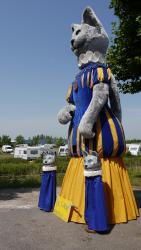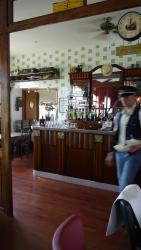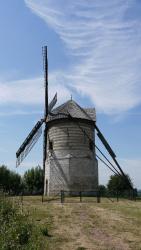 According to the official pamphlet, French Flanders brings ‘Real France, Real Close’. With Calais to the west, Dunkirk in the north, Brussels to the east and Lille at its South, it is certainly accessible, although possibly for many motorists, little more than a via point. However going on my recent adventure to the flatlands of giants, swamps and the ‘endless screw’, it was the first time I’ve seen an expression of France quite like it.
According to the official pamphlet, French Flanders brings ‘Real France, Real Close’. With Calais to the west, Dunkirk in the north, Brussels to the east and Lille at its South, it is certainly accessible, although possibly for many motorists, little more than a via point. However going on my recent adventure to the flatlands of giants, swamps and the ‘endless screw’, it was the first time I’ve seen an expression of France quite like it.
Judging by their itinerary, the tourist board wanted to show press another face of Flanders beyond the iconic poppy fields and regular headstones. This is not meant disrespectfully, but recognising reality, as the immediate relatives of war veterans expire, it is only natural that tourism here must adapt to a fresh generation who are more immediately interested in a short break over a sombre pilgrimage.
Less than an hour from Calais is border town Ghyvelde, a breeding ground for ostriches, pheasants, rabbits and possibly the more virile campers and holiday homeowners who are well catered for here. It is also home to award-winning floral roundabouts, a horse mown fossil dune which stretches to Dunkirk, and an imposing mock up of effective marsh drainer, the endless screw, which our guide demonstrated with vim.
Flax Farm
Moments from the little town’s heart, bound for linen capital, Hondschoote, our bus entered a flat sea of flowering flax. Trying to look towards Flanders’ future, it became harder than ever to refrain from mentioning the war. Indeed, much of the 14,000 hectares covered by this slender, blue-tipped, ancient crop was flooded by Germans in the First World War. Indeed, our guide claims to find seashells in her garden (which is also sewn with Chardonnay vines).
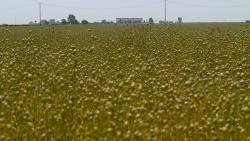 A disease resistant, relatively natural crop, flax has many uses. Observed at a third generation factory, when initially processed, its stems look like a greying Dougal from the ‘Magic Roundabout’. These are split and woven into linens in China’s sweatshops. Its spicy sprouts may also be eaten, as can the crisp but laxative seeds which are frequently pressed for their oils. It also has high potential as a fibre for the future and as a polymer, has similar properties to glass reinforced plastic.
A disease resistant, relatively natural crop, flax has many uses. Observed at a third generation factory, when initially processed, its stems look like a greying Dougal from the ‘Magic Roundabout’. These are split and woven into linens in China’s sweatshops. Its spicy sprouts may also be eaten, as can the crisp but laxative seeds which are frequently pressed for their oils. It also has high potential as a fibre for the future and as a polymer, has similar properties to glass reinforced plastic.
At Hondschoote, which was once part of the Spanish Netherlands, I watched carnival types erect the funfair besides the towering church. Our guide introduced us to ‘Picon’, a Coca Cola coloured, bittersweet aperitif not unlike Campari. Made with orange, gentian, quinquina and caramel, this potion is liberally stirred into beer. But rather than Stella Artois, I chose another local brew – the sturdier (8.5%) cask matured ‘Trois Monts’ beer.
Burnt Beer
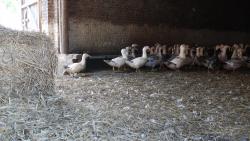 Beer and mountains also featured during lunch at ‘Auberge Flamande’, Watten. The village is best known for its windmill topped mini ‘mountain’. At 72 metres above sea level, this provided German troops with a strategic observation post. Being too many to sit in the inn’s cheap and cheerful brasserie, we instead found ourselves shoe-horned into the somewhat salacious disco above. Normally the scene of the monthly transvestite show, the glitter-balled, glitter-walled, dark arena was festooned with witches on broomsticks and caricatures of men overly made up as women. The aroma of well-worn, warm latex was almost tangible alongside my wintry Flemish stew, and then musky, hoppy, burnt beer tart.
Beer and mountains also featured during lunch at ‘Auberge Flamande’, Watten. The village is best known for its windmill topped mini ‘mountain’. At 72 metres above sea level, this provided German troops with a strategic observation post. Being too many to sit in the inn’s cheap and cheerful brasserie, we instead found ourselves shoe-horned into the somewhat salacious disco above. Normally the scene of the monthly transvestite show, the glitter-balled, glitter-walled, dark arena was festooned with witches on broomsticks and caricatures of men overly made up as women. The aroma of well-worn, warm latex was almost tangible alongside my wintry Flemish stew, and then musky, hoppy, burnt beer tart.
I anticipated a lazy afternoon, meandering miles of swamps around Nierulet aboard purpose built, shallow draft craft, ‘Brouckailler’. Smallholders of artichokes and cauliflowers waived; dragonflies whirred by and swans overtook us. My eyes gradually grew heavier. But the journey’s tranquillity was rudely punctuated. As low bridges loomed, passengers were forced to take up the brace position, or face decapitation.
Later, at duck farm, ‘Ferme aux Canards de la Mère Miche’, artisan, François Dewevre led us into a former fridge for a showing of his Borat-esque homemade video. It illustrated, in some detail, the force feeding (gavage) of his flock for foie gras. Although Dewevre clearly loved his ducks and allowed them plentiful space and rest, one journalist found the close up of feeder delved deep into gullets too much to stomach. That there was a modern jazz soundtrack on the film rendered the spectacle extraordinary. Regardless, I greatly enjoyed the degustation of Dewevre’s impeccable products, aptly matched with clear honey scented Loire white, Savennières.
Although ‘Trip Advisor’ alerts against it, we received a warm welcome at the ‘Auberge de la Foret’, in the outskirts of Hazebrouck. Despite its lived-in feel, the restaurant proved pleasant, with a surprisingly extensive wine list majoring on back vintage Bordeaux. Spooned against music more appropriate for a Bela Lugosi film than a light supper, the standout dish was actually the cleanser of cherry beer sorbet.
Despite twice being a major military target, the town has imposing buildings, including the eclectically stocked museum ‘des Augustins’. Located off a glittering road, the former friary is worth visiting on account of its borrowed Rubens, traditional Flemish kitchen and moving video, ‘disappearance of a tribe’ by Lithuanian artist, Deimantas Narkevicius. It is also the resting place of the town’s gaudy ‘giants’, Roland, Tijse-Tajse, Toria and Babe-Tajse. Being in their presence felt like being transposed into an episode of ‘The Borrowers’.
Inexplicably, our guide substituted a trip to a brewery for a meeting with another giant. Apparently the tall, ruffed cat Queen or ‘caou’ harks back to the sixteenth century when a real cat – ‘symbol of lust and the Devil’ – was locked in the Parish church of Merville during a Protestant revolt. The sheer mascot is seen by its 30 custodians as a ‘real person’ and as such, was baptised in millennium year. To make it ‘dance’, the strongest supporters enter the giant pussy (which looks internally like the workings of a rugby scrum machine) whilst ladies ‘must’ stroke its tail.
Out of context, the ritual seems beyond bizarre, although I am reliably informed that, rather than a tall tale, the tradition of giants in these northern parts is long standing. In Britain, distractions such as cheese rolling and Morris dancing keep the more mature generation out of trouble. In Flanders, they groom then parade blasphemously baptised, furry beasts. Arguably, there is less of a difference between these activities then one might think…
Our final lunch occurred in a railway station removed from the network a decade ago to allow for a faster line. Dressed in station master’s garb, the waiter at the ‘Gare des Années Folle’ evoked a member of the ‘Village People’. The highlight was a brioche filled cup of molten Maroilles, a cow’s milk cheese from Picardy. Next door, seven small bedrooms occupy a static carriage.
After a visit to a jolly workshop of very big organs in Steenwerk, my final morsel was taken at the nearby ‘Musée de la Vie Rurale’. The unleavened Flemish waffle tastefully fused caramel and pancakes in a chewy sandwich.
The whistle-stop tour had provided an intriguing insight into a peaceful, laid back part of France. Sometimes surreal, but always friendly, I will no longer see this low land as a point through which to pass but an intriguing destination…
To plan your visit, see: www.paysdeflandre.fr
Douglas travelled by Eurostar from London St. Pancras to Calais Frethun
Auberge Flammande – 2 Grand Place 59143 Watten. T. +33 (0)3 21 885 616
Le Brouckailler – Le Marais Flamand, 1 La Place 59143 Nieurlet. T. +33 (0)3 21 88 19 00
Ferme aux Canards de la Mère Miche – 11 Rue de Ham 49143 Nieurlet. T. +33 (0)3 21 88 04 60
Auberge de la Foret – La Motte au Bois 59190 Hazebrouck. T. + 33 (0)3 28 48 08 78
Musée des Augustins – Ancien Couvent des Augustins, Place Georges Degroote 59190 Hazebrouck. T. +33 (0)3 28 43 44 46
Gare des Années Folle – 77 Rue de la Gare 62840 Sailly-sur-La Lys. T. +33 (0)3 21 02 68 20
La Ferme des Orgues – 2 Rue de l’Hollebecque 59181 Steenwerck. T. +33 (0)3 28 49 13 13
Musée de la Vie Rurale – 49 Rue du Musée 59181 Steenwerck. T. +33 (0)3 28 50 33 80

